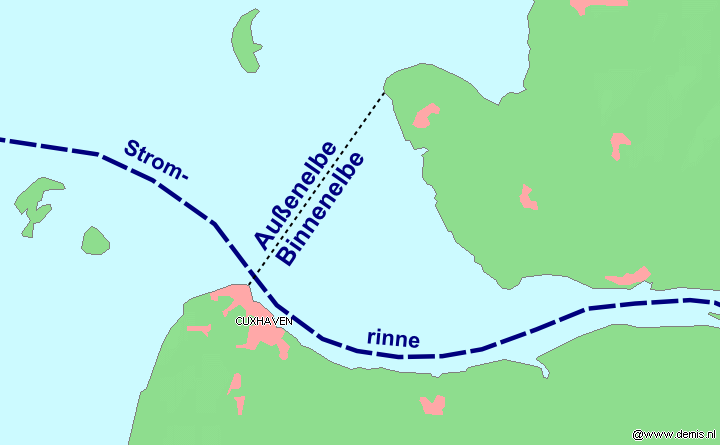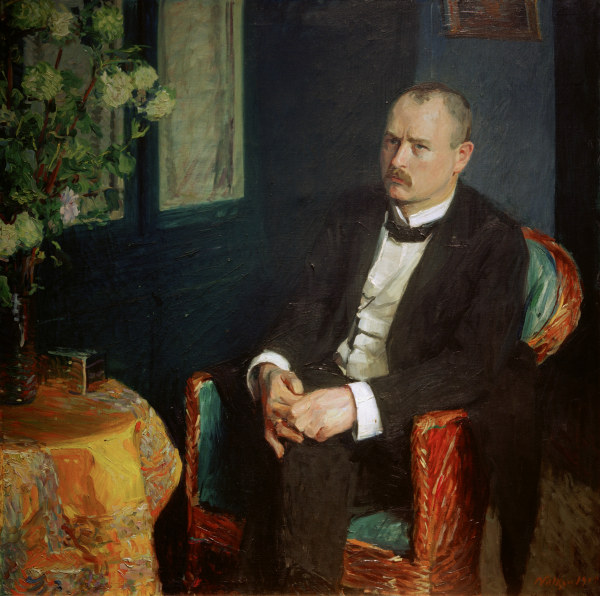|
Carl Rodeck
Carl Rodeck (13 September 1841 – 14 April 1909) was a German landscape, marine and portrait painter. Early life and education His father was a lithographer and, in 1842, his family moved to Hamburg to open their own shop. From 1863 to 1866, he studied under Arnold Böcklin, Ferdinand Pauwels and Alexander Michelis at the Weimar Saxon Grand Ducal Art School. After a brief return to Hamburg in 1869, prompted by his father's illness, he went to Berlin for further studies then, in 1871, went back to Hamburg, where he took up permanent residence. Career After his father's death he closed the shop and devoted himself entirely to painting. He quickly found the themes for his works; mainly oil paintings or watercolors. He portrayed the German forest, the landscape of the Lower Elbe and the old harbor neighborhood of Hamburg and was constantly on the road with a sketch pad or easel. In 1869 the ' had been his first customer, and continued to buy his works throughout the 1870s. He ... [...More Info...] [...Related Items...] OR: [Wikipedia] [Google] [Baidu] |
Emden
Emden () is an independent city and seaport in Lower Saxony in the northwest of Germany, on the river Ems. It is the main city of the region of East Frisia and, in 2011, had a total population of 51,528. History The exact founding date of Emden is unknown, but it has existed at least since the 8th century. Older names for Emden are Setutanda, Amuthon, Embda, Emda, Embden and Embderland. Town privilege and the town's coat of arms, the ''Engelke up de Muer'' (The Little Angel on the Wall) was granted by Emperor Maximilian I in 1495. In the 16th century, Emden briefly became an important centre for the Protestant Reformation under the rule of Countess Anna von Oldenburg who was determined to find a religious "third way" between Lutheranism and Catholicism. In 1542 she invited the Polish noble John Laski (or ''Johannes a Lasco'') to become pastor of a Protestant church at Emden; and for 7 years he continued to spread the new religion around the area of East Frisia. However, ... [...More Info...] [...Related Items...] OR: [Wikipedia] [Google] [Baidu] |
Unterelbe
The Unterelbe or, in English usually the Lower Elbe, refers to the lower reaches of the river Elbe in Germany influenced by the tides. It starts at kilometre 586, at the sluice of Geesthacht, where the Elbe forms the border between Lower Saxony and Schleswig-Holstein. It continues downstream, then forming the border between Lower Saxony and Hamburg, before fully entering Hamburg territory. In Hamburg the Unterelbe forms two anabranches, Norderelbe and Süderelbe, the latter now partially a cut-off meander. Where Norderelbe and Süderelbe used to reunite, at kilometre 634 there is a bay called the . This marks the beginning of the section of the Unterelbe which called the Niederelbe. After leaving Hamburg it forms the border between Lower Saxony and Schleswig-Holstein, again. The end it defined by the Kugelbake in Cuxhaven at kilometre 727.73. It continues further into the Wadden Sea as the Außenelbe, where it passes the Hamburg islands Scharhörn and Nigehörn. See als ... [...More Info...] [...Related Items...] OR: [Wikipedia] [Google] [Baidu] |
Artists From Hamburg
An artist is a person engaged in an activity related to creating art, practicing the arts, or demonstrating an art. The common usage in both everyday speech and academic discourse refers to a practitioner in the visual arts only. However, the term is also often used in the entertainment business, especially in a business context, for musicians and other performers (although less often for actors). "Artiste" (French for artist) is a variant used in English in this context, but this use has become rare. Use of the term "artist" to describe writers is valid, but less common, and mostly restricted to contexts like used in criticism. Dictionary definitions The ''Oxford English Dictionary'' defines the older broad meanings of the term "artist": * A learned person or Master of Arts. * One who pursues a practical science, traditionally medicine, astrology, alchemy, chemistry. * A follower of a pursuit in which skill comes by study or practice. * A follower of a manual art, such as a m ... [...More Info...] [...Related Items...] OR: [Wikipedia] [Google] [Baidu] |
19th-century German Male Artists
The 19th (nineteenth) century began on 1 January 1801 ( MDCCCI), and ended on 31 December 1900 ( MCM). The 19th century was the ninth century of the 2nd millennium. The 19th century was characterized by vast social upheaval. Slavery was abolished in much of Europe and the Americas. The First Industrial Revolution, though it began in the late 18th century, expanding beyond its British homeland for the first time during this century, particularly remaking the economies and societies of the Low Countries, the Rhineland, Northern Italy, and the Northeastern United States. A few decades later, the Second Industrial Revolution led to ever more massive urbanization and much higher levels of productivity, profit, and prosperity, a pattern that continued into the 20th century. The Islamic gunpowder empires fell into decline and European imperialism brought much of South Asia, Southeast Asia, and almost all of Africa under colonial rule. It was also marked by the collapse of the large S ... [...More Info...] [...Related Items...] OR: [Wikipedia] [Google] [Baidu] |
19th-century German Painters
The 19th (nineteenth) century began on 1 January 1801 ( MDCCCI), and ended on 31 December 1900 ( MCM). The 19th century was the ninth century of the 2nd millennium. The 19th century was characterized by vast social upheaval. Slavery was abolished in much of Europe and the Americas. The First Industrial Revolution, though it began in the late 18th century, expanding beyond its British homeland for the first time during this century, particularly remaking the economies and societies of the Low Countries, the Rhineland, Northern Italy, and the Northeastern United States. A few decades later, the Second Industrial Revolution led to ever more massive urbanization and much higher levels of productivity, profit, and prosperity, a pattern that continued into the 20th century. The Islamic gunpowder empires fell into decline and European imperialism brought much of South Asia, Southeast Asia, and almost all of Africa under colonial rule. It was also marked by the collapse of the large S ... [...More Info...] [...Related Items...] OR: [Wikipedia] [Google] [Baidu] |
Ernst Rump
Ernst August Max Friedrich Rump (13 October 1872, Hamburg - 12 January 1921, Hamburg) was a German merchant, art patron and collector. In 1912, he wrote the ''Lexikon der bildenden Künstler Hamburgs, Altonas und der näheren Umgebung'' (Encyclopedia of Visual Artists from Hamburg, Altonas and the Surrounding Area), which became a classic; generally referred to as ''Der Rump''. Life and career He learned the art of etching in London, from James McNeill Whistler, and gave lessons in Hamburg. When he took over the family business (nautical equipment), he became an avid art collector and patron of young artists; especially those in the . He gave special attention to the students of Arthur Siebelist; buying their works and organizing exhibitions. He also supported Alfred Lichtwark, the Director of the Kunsthalle Hamburg although, in 1908, he criticized him for ignoring Siebelist's students. A few years later, he would have a change of heart himself, when some of his favorite art ... [...More Info...] [...Related Items...] OR: [Wikipedia] [Google] [Baidu] |
Thieme-Becker
Thieme-Becker is a German biographical dictionary of artists. Thieme-Becker The dictionary was begun under the editorship of Ulrich Thieme (1865–1922) (volumes one to fifteen) and Felix Becker (1864–1928) (volumes one to four). It was completed under the editorship of Frederick Charles Willis (b. 1883) (volumes fourteen and fifteen) and Hans Vollmer (1878–1969) (volumes sixteen to thirty-seven)."The Project: From Thieme-Becker to the Artists’ Database," GmbH.Heinz Ladendorf, "Das Allgemeine Lexikon der bildenden Künstler Thieme-Becker-Vollmer," in Magdalena George (ed.), ''Festschrift Hans Vollmer'' ... [...More Info...] [...Related Items...] OR: [Wikipedia] [Google] [Baidu] |
Kelvingrove Art Gallery And Museum
Kelvingrove Art Gallery and Museum is a museum and art gallery in Glasgow, Scotland. It reopened in 2006 after a three-year refurbishment and since then has been one of Scotland's most popular visitor attractions. The museum has 22 galleries, housing a range of exhibits, including Renaissance art, taxidermy, and artefacts from ancient Egypt. Location The gallery is located on Argyle Street, in the West End of the city, on the banks of the River Kelvin (opposite the architecturally similar Kelvin Hall, which was built in matching style in the 1920s, after the previous hall had been destroyed by fire). It is adjacent to Kelvingrove Park and is near the main campus of the University of Glasgow on Gilmorehill. Original museum The original Kelvingrove Museum opened in 1876. It was housed in a much enlarged 18th-century mansion called Kelvingrove House, to the north-east of the current site, that was originally the home of Lord Provost Patrick Colquhoun. Creation (1888–1901) ... [...More Info...] [...Related Items...] OR: [Wikipedia] [Google] [Baidu] |
Ohlsdorf Cemetery
Ohlsdorf Cemetery (german: Ohlsdorfer Friedhof or (former) ) in the Ohlsdorf quarter of the city of Hamburg, Germany, is the biggest rural cemetery in the world and the fourth-largest cemetery in the world. Most of the people buried at the cemetery are civilians, but there is also a large number of victims of war from various nations. The cemetery notably includes the Old Hamburg Memorial Cemetery (''Althamburgischer Gedächtnisfriedhof'', formerly ''Ehrenfriedhof'') with the graves of many notable Hamburg citizens. History and description In 1877 the Ohlsdorf Cemetery was established as a non-denominational and multi-regional burial site outside of Hamburg. The cemetery has an area of with 12 chapels, over 1.5 million burials in more than 280,000 burial sites and streets with a length of . There are 4 entrances for vehicles and public transport is provided with 25 bus stops of two bus lines of the Hamburger Verkehrsverbund. The cemetery is not only used as a burial ground, ... [...More Info...] [...Related Items...] OR: [Wikipedia] [Google] [Baidu] |
Helene Cramer
Helene Cramer (13 December 1844 – 14 April 1916) was a German flower, landscape and portrait painter. Life Cramer came from a wealthy merchant family in Hamburg-Uhlenhorst. Like her sister, the painter Molly Cramer, she also began her training as a painter in 1882 after the death of their father Cesar Cramer. At the beginning of their studies Helene was 38 years old. The sisters first teachers were the Hamburg illustrator as well as the painters Carl Rodeck and Carl Oesterley. At the end of the 1880s Helene Cramer went to The Hague to train under Margaretha Roosenboom and together with her sister at the Belgian still life painter Eugène Joors in Antwerp. Joors taught them in the art of still life painting. Returning to Hamburg, Helene Cramer mainly painted still life flower pieces. Her works were regularly exhibited at major German exhibitions, such as at the Glass Palace Munich and the Great Berlin Art Exhibition (Große Berliner Kunstausstellung). In Berlin she exhibi ... [...More Info...] [...Related Items...] OR: [Wikipedia] [Google] [Baidu] |







